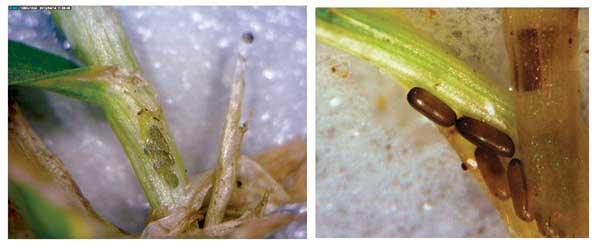Impact of greens cutting heights on annual bluegrass weevil

L: Eggs inside stem of plant at fairway height (0.5 in.). R: Eggs deposited in putting green height (0.125 in.) were loose or outside plant. (Photos: Mike Kenna)
The annual bluegrass weevil (Listronotus maculicollis) is the most destructive insect pest of golf course turf in eastern North America. At Penn State University, we observed putting greens are rarely damaged, yet collars adjacent to the same putting greens are damaged. We investigated the effect of cutting height on the establishment of annual bluegrass weevil populations on putting greens.
Initial greenhouse studies demonstrated that between 26 percent and 38 percent of adults were removed when the turfgrass was mowed at 0.1 inch, but the effect diminished with increasing mowing heights. Most adults survived mowing, indicating a potential for adults to reinvade turf stands adjacent to areas where grass clippings are discarded.
Females laid eggs in all of the mowing-height treatments in laboratory and field experiments. However, behavior was influenced by plant height, as significantly fewer eggs were placed inside of the turfgrass stem at the lowest mowing height. Larval development was not affected by egg placement or turfgrass height. Significant numbers of larvae were capable of damaging turfgrass at all cutting height treatments.
Field studies compared the effect of double-cutting versus the effect of a single mowing. Height of cut — but not frequency — had a significant effect on the number of adults removed. The 0.1-inch cutting height removed 50 percent of the adults. Both mowing frequency treatments had minimal impact on adult mortality, though significantly more adults were killed in double-cutting treatments at lower mowing heights. Laboratory studies using time-lapse photography revealed that temperature has a significant effect on adult activity on top of the grass canopy. The activity was greatest between 60 degrees F and 68 degrees F, and they observed only low percentages on top of the canopy when temperatures were 50 degrees F or less. Adult activity on top of the turfgrass canopy was greatest during the day and strongly correlated with temperature early in the season (April and May). Adult activity in June was highest briefly after sunrise, then declined once temperatures exceeded 68 degrees F. These results predict adults are most active on the surface between 57 degrees F and 63 degrees F. Timing mowing events around these conditions in spring may lead to improved annual bluegrass weevil removal.
This project was funded in part by the USGA Green Section.










